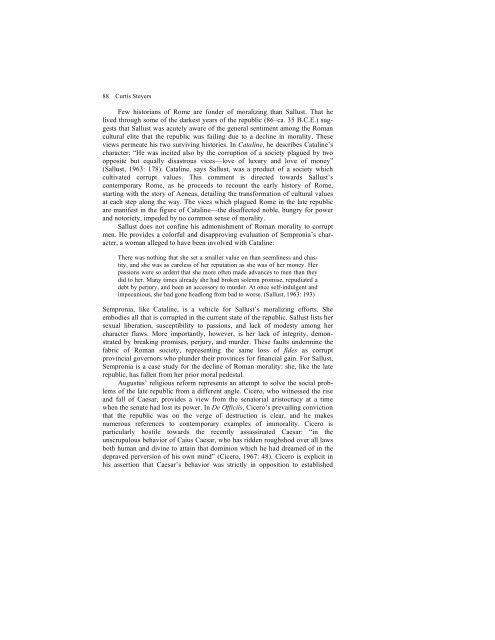Create successful ePaper yourself
Turn your PDF publications into a flip-book with our unique Google optimized e-Paper software.
88 Curtis Steyers<br />
Few historians of Rome are fonder of moralizing than Sallust. That he<br />
lived through some of the darkest years of the republic (86–ca. 35 B.C.E.) suggests<br />
that Sallust was acutely aware of the general sentiment among the Roman<br />
cultural elite that the republic was failing due to a decline in morality. These<br />
views permeate his two surviving histories. In Cataline, he describes Cataline’s<br />
character: “He was incited also by the corruption of a society plagued by two<br />
opposite but equally disastrous vices—love of luxury and love of money”<br />
(Sallust, <strong>19</strong>63: 178). Cataline, says Sallust, was a product of a society which<br />
cultivated corrupt values. This comment is directed towards Sallust’s<br />
contemporary Rome, as he proceeds to recount the early history of Rome,<br />
starting with the story of Aeneas, detailing the transformation of cultural values<br />
at each step along the way. The vices which plagued Rome in the late republic<br />
are manifest in the figure of Cataline—the disaffected noble, hungry for power<br />
and notoriety, impeded by no common sense of morality.<br />
Sallust does not confine his admonishment of Roman morality to corrupt<br />
men. He provides a colorful and disapproving evaluation of Sempronia’s character,<br />
a woman alleged to have been involved with Cataline:<br />
There was nothing that she set a smaller value on than seemliness and chastity,<br />
and she was as careless of her reputation as she was of her money. Her<br />
passions were so ardent that she more often made advances to men than they<br />
did to her. Many times already she had broken solemn promise, repudiated a<br />
debt by perjury, and been an accessory to murder. At once self-indulgent and<br />
impecunious, she had gone headlong from bad to worse. (Sallust, <strong>19</strong>63: <strong>19</strong>3)<br />
Sempronia, like Cataline, is a vehicle for Sallust’s moralizing efforts. She<br />
embodies all that is corrupted in the current state of the republic. Sallust lists her<br />
sexual liberation, susceptibility to passions, and lack of modesty among her<br />
character flaws. More importantly, however, is her lack of integrity, demonstrated<br />
by breaking promises, perjury, and murder. These faults undermine the<br />
fabric of Roman society, representing the same loss of fides as corrupt<br />
provincial governors who plunder their provinces for financial gain. For Sallust,<br />
Sempronia is a case study for the decline of Roman morality: she, like the late<br />
republic, has fallen from her prior moral pedestal.<br />
Augustus’ religious reform represents an attempt to solve the social problems<br />
of the late republic from a different angle. Cicero, who witnessed the rise<br />
and fall of Caesar, provides a view from the senatorial aristocracy at a time<br />
when the senate had lost its power. In De Officiis, Cicero’s prevailing conviction<br />
that the republic was on the verge of destruction is clear, and he makes<br />
numerous references to contemporary examples of immorality. Cicero is<br />
particularly hostile towards the recently assassinated Caesar: “in the<br />
unscrupulous behavior of Caius Caesar, who has ridden roughshod over all laws<br />
both human and divine to attain that dominion which he had dreamed of in the<br />
depraved perversion of his own mind” (Cicero, <strong>19</strong>67: 48). Cicero is explicit in<br />
his assertion that Caesar’s behavior was strictly in opposition to established

















